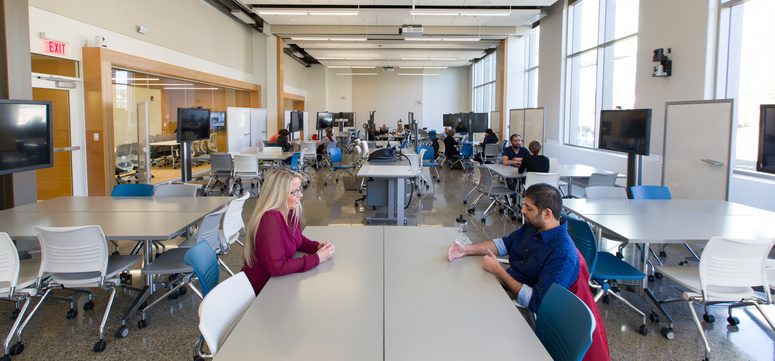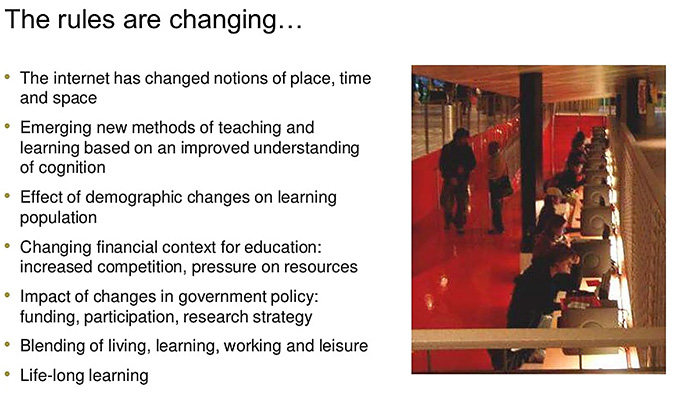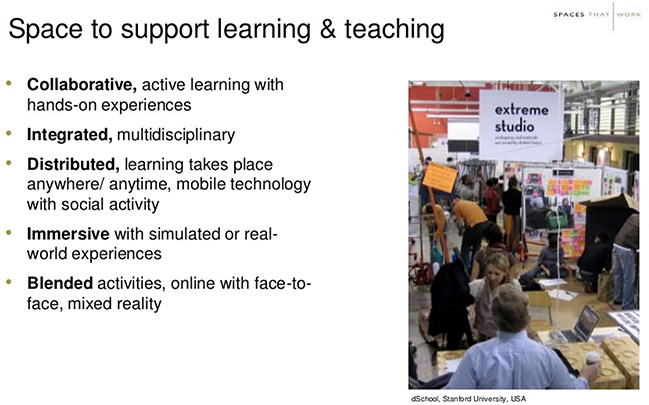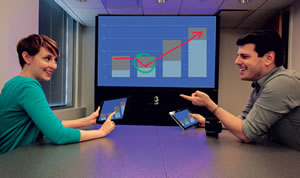‘Anyone who walks into these spaces wants to teach in them’ — from ucalgary.ca by Joni Miltenburg
Instructors can apply to teach in the Taylor Institute’s flexible learning space
Excerpt:
Leighton Wilks noticed a palpable difference when his class moved from a traditional lecture-style classroom to an active learning space. Not only did attendance increase, but students were more engaged and collaborative.
“I see a lot more team cohesion. They’re talking more to each other because they’re sitting with their teams. It’s nice to foster that teamwork throughout the semester.”
Wilks is an instructor in the Haskayne School of Business and teaches a second-year organizational behaviour course in the newly-renovated active learning classroom in Scurfield Hall. He found that the space breaks down the boundary between instructor and student.
“Instead of being up at the front, I’m walking around. I feel I get a lot more questions and get to know the students better, which is important.”
From DSC:
Also see my notes from this year’s Next Generation Learning Spaces Conference.
Creating Great Digital Spaces for Learning — from slideshare.net by Phil Vincent
Professor Andrew Harrison, Professor of Practice at University of Wales Trinity St David and Director, Spaces That Work Ltd., from Jisc DigiFest 2016
21st-century learning environments — from webcpm.com by Kenneth A. Gruskin, Michael Searson
Excerpts:
Pedagogy
Preparation for the 21st-century workforce demands that educators shift the authority for learning to the students. After all, today’s workers are expected to function in collaborative and horizontal environments, as opposed to the “factory” driven, top-down, solitary worker spaces of yesterday. Therefore, contemporary learning environments should lean heavily on collaborative spaces, supported through personalized learning technologies. Good pedagogy encourages student engagement through complex collaborative projects based on real-world problems.
…
Technology
Innovative learning should incorporate a true BYOD (bring your own device) environment that provides opportunities for student-centered learning, beginning with their own personalized technologies — from laptops and tablets to smartphones and wearable devices. This approach leverages student devices and reduces the need for institutionally provided equipment.
…
Supporting Distance Learning
Strategies being used within Unified Communications and Collaboration solutions provide the means to support the involvement of remote participants, whether they are present on the WAN or solely connecting via Internet services. Since these solutions are moving to cloud-based topologies, they are mostly services that individuals subscribe to directly or have access to through campus-based subscription services. These features are also beginning to appear in social media environments, such as Facebook and LinkedIn, so the opportunity for use may become as easy as installing another app in the not-toodistant future.
Engaging students with interactive technologies — from webcpm.com by Bill Nattress
Excerpt:
Wireless presentation, lecture capture, online collaboration and active-learning methodologies all require the ability for any and all participants to engage the installed resources within the facility while they also access their personal content; whether local to their personal devices or within the cloud. With the video tools now available to the consumer, the use of conferencing apps will continue to rise. The environments that engage students and faculty will need to allow for any user to log in and access his or her content and presentation appliances without hurdles or roadblocks. Access to subject matter experts or other individuals will also need to be supported as well. With the deployment of video tools via social media, users will also rely more on their personal accounts for contact management instead of an address book. These changes in workflow are disruptors to the policies that many institutions have put in place as it relates to the BYOD usage surrounding their networks. Success of these communication and education solutions needs the networks to focus on and easily support three key technologies: wireless presentation, collaboration and participation by remote team members.













